
East Grinstead High Level Station: Gallery 3: 1959 - c1962
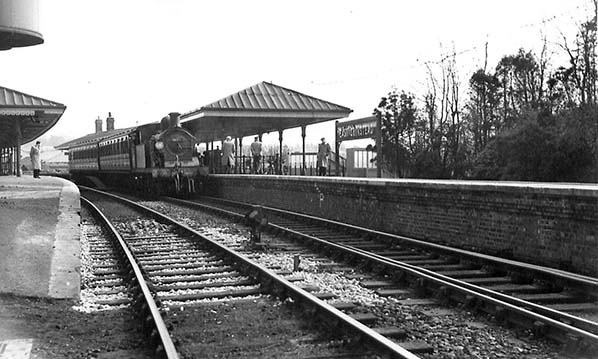 On an unknown date during the British Railways period an unidentified H Class 0-4-4T pauses at East Grinstead. One gets the feeling the raincoated gentlemen apparently casually standing around are railway enthusiasts. Perhaps, therefore, the occasion was the final closure of the East Grinstead Low Level - Culver Junction line in March 1958. Directly ahead of the camera the upper landings of the Low Level station's footbridge can be seen.
Photo from John Mann collection 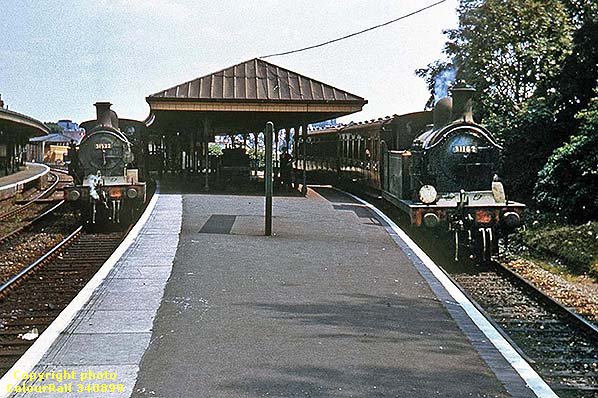
During March 1959 H Class locomotives Nos. 31522 and 31162 pause at East Grinstead High Level. The headcode displayed by No. 31162 had signified Tunbridge Wells West - Oxted via East Grinstead but it was not possible to access the Oxted line from this platform. Alterations to these headcodes occurred from time to time going right back to Pre-Grouping days and British Railways made further changes during the 1958 - 1961 period. In this photograph, therefore, the meaning of both headcodes is unclear.
Copyright photo from ColourRail 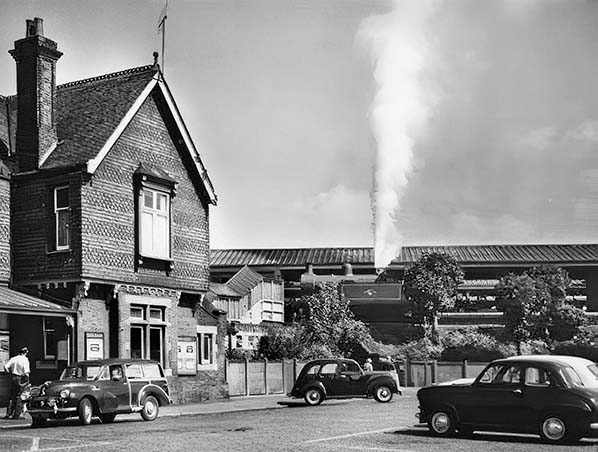
Viewed from the forecourt, with the station building on the left, a Class H 0-4-4T sits in the High Level Platform 3 on 4 July 1959. The decoration of the station building was typical of Lewes & East Grinstead Railway buildings but perhaps not quite to everybody's taste, being bordering upon over-elaborate. This building was demolished during 1970 - 1971, to be replaced by one of the ghastly CLASP structures sited a little further south. The present (2023) station building dates from 2013. Potential competition lurks on the forecourt in the form of, left to right, a Morris Minor Traveller, what appears to be a Ford Prefect E493A and an Austin A35 plus one other unidentified vehicle. The H Class locomotive's safety valves are blowing off and while the noise would have been very loud nobody is taking any notice, such was the familiarity with steam locomotives at the time.
Photo from Ted Burgess 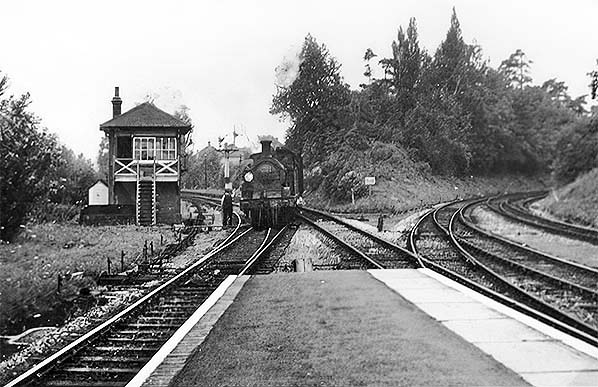
Sometime after 1958 an unidentified, but possibly No. 31518, H class 0-4-4T arrives from Three Bridges. The train is running into Platform 3. There had been a LBSCR wooden post, lower quadrant signal at the end of this platform directly ahead of the camera. This had been replaced by an upper quadrant signal on the familiar Southern style post made from redundant rails, positioned out of view to the left. Although unconfirmed, it is possible the replacement signals installed at High Level, including the bracket signal in the background, were recovered from the Low Level - Culver Junction line which had finally closed in 1958, insofar as BR was concerned, but part of which now forms the heritage Bluebell Railway.
Photo
from John Mann collection
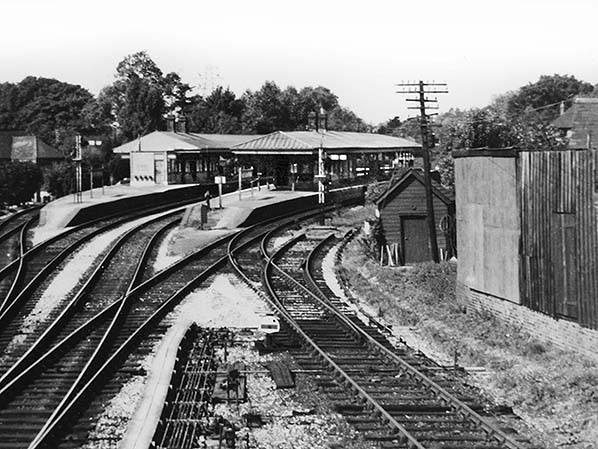
Facing west towards Rowfant and Three Bridges, presumably from the East (B) signal box. The trap siding, centre, protected the Platform 6 running line from runaway wagons and errant locomotives on the north side timber yard siding. It ends at a sand drag which appears too small to have offered much protection from anything other than a very slow moving wagon. The points, controlled by the ground signal, are set for the trap siding and this was the normal position when no traffic needed to enter or leave the siding. This view predates the east facing equivalent above as in that view the telegraph pole in front of the hut was not present. This view therefore is probably pre 1958.
Photo by Alan & Lynne Cullen 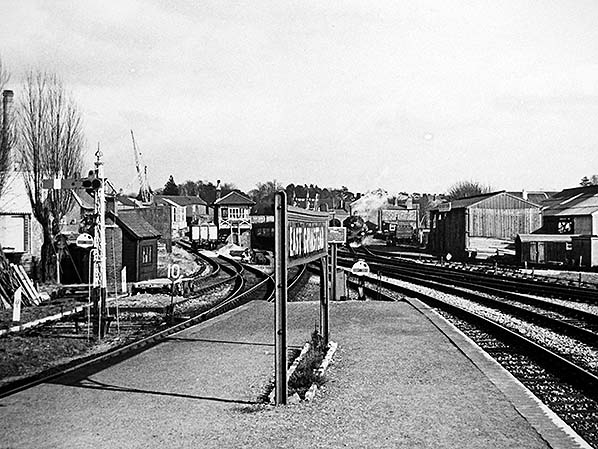 Facing east towards Forest Row from the end of Platforms 4/5. An unidentified Class C2X locomotive lurks in the sidings directly ahead of the camera. Behind and to the right of the locomotive is the site of the original terminus station. Timber yards are present on the right and in the left background, both were rail served. On the left, behind the '10' speed limit warning, two platelayer's trolleys sit in the trap siding. This siding is better seen and described in another caption. Note ornate lattice post signal complete with finial. At far left a milepost tells us the location was 30 miles 20 chains from Victoria via Oxted. This end of High Level and its yards were at ground level, with the rest of the station being on embankment and bridges.
Photo by Alan & Lynne Cullen 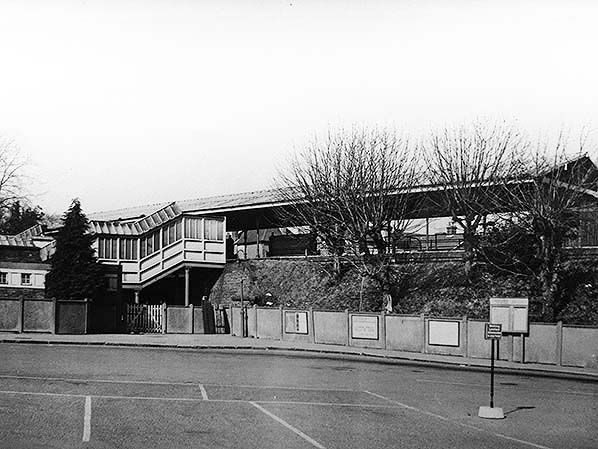 East Grinstead station forecourt in BR days. The station entrance is out of view to the left. The covered stairs led to the subway to the high level platforms 3/4.
Photo from John Mann collection 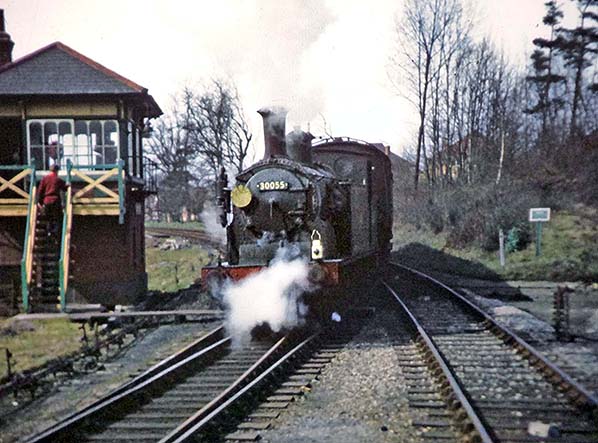
Ex LSWR Drummond Class M7 0-4-4T No. 30055 has departed from Platform 3 and is at the rear of a Push-Pull set bound for Three Bridges. Apart from the obvious, being taken in BR days, there is little visible which would help narrow down the date. The track branching off to the left beneath the locomotive was a siding. Between 1955 and withdrawal in 1963 No. 30055 spent time at both Three Bridges and Tunbridge Wells West sheds in between shuffling around between a few other sheds. She was to fall under the spotlight on 5 February 1955 when she operated the final passenger train over the Alton - Fareham (Meon Valley) line decorated with various adornments as was commonplace for such 'last train' occasions.
Photo by Alan & Lynne Cullen 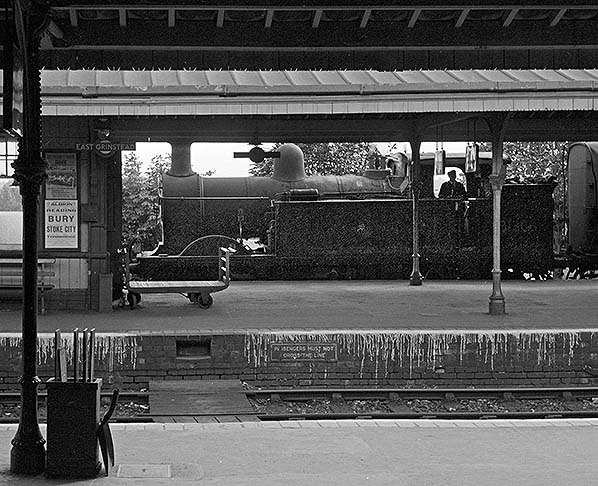
On 10 September 1961 Class H No. 31308 stands at Platform 3 with a crew member watching from the footplate. This locomotive would be withdrawn from Tunbridge Wells West shed on 23 December 1962. Photographs of this station taken beneath the canopies have proved to be uncommon and we are grateful for the detail on view in this example. Visible are two Southern Railway 'target' signs announcing the station name, with both illuminated by gas lights. Two platform number signs are suspended beneath the far canopy, for Platforms 3 and 4; these signs were only found beneath the canopies and near the subway entrances which was really all that was necessary. Similar signage would have been found in the subway, informing passengers which staircase they should ascend as well as signage directing passengers to Low Level Platforms 1 and 2. On the left are advertisements for Hove Greyhound Stadium (top) and for various Brighton & Hove Albion F. C. matches (bottom). Across the tracks is a staff crossing with footstep in the platform face along with a 'Passengers must not cross the line' warning. More usually these warnings went on to say 'Except by means of the footbridge [or subway as applicable]' but the Southern Railway obviously deemed the abridged wording adequate. At left foreground are a set of train destination indicator boards. These would be slotted into the device suspended at top left and set to point towards which ever platform was relevant. They were the forerunner of today's electronic departure indicators and can still be seen at certain heritage railways. This scene is generally neat and tidy, spoiled only by the whitewash running down the platform face from the edging.
Photo by Ian D Noble from his Flickr photostream 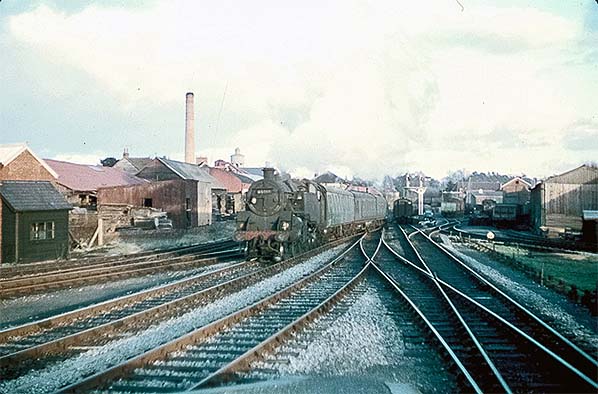
On 13 January 1962 a BR Standard 4MT 2-6-4T approaches from the Tunbridge Wells direction. The locomotive is thought to be No. 80015. Assuming so, she had been built at Brighton in 1951 and allocated from new to Tunbridge Wells West. She was destined to survive until the end of steam on the Southern Region on 9 July 1967, by that time allocated to Nine Elms. To the left and largely obscured from view by the train was a siding serving a timber yard while at centre right the siding which had connected to the East Grinstead Low Level - Culver Junction line can be seen branching off. The original terminus station was located in the right background.
Photo by John M. Cramp from 20937 transport Photograph Database 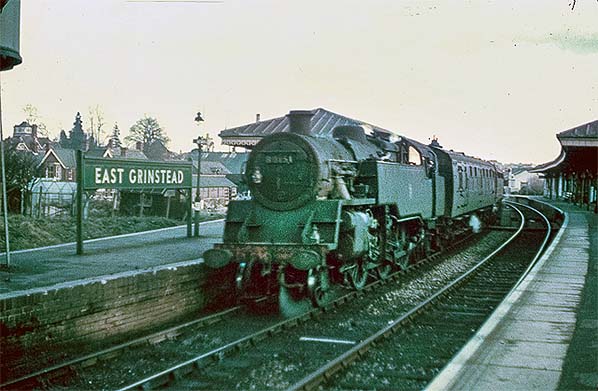 On 13 January 1962 BR Standard 4MT 2-6-4T No. 80151 arrives with a train from Tunbridge Wells West. This train will branch off at East Grinstead West Junction to take the St Margaret's Curve to Oxted and Victoria. Another Brighton-built example, No. 80151 was one the final batch and did not enter service until January 1957. Allocated to Brighton shed from new, she was still so-allocated when photographed and had probably worked up to Tunbridge Wells West via Hailsham and Eridge. She missed the end of steam on the Southern Region, being withdrawn on 7 May 1967 from Eastleigh shed, but is one of several class members to have survived into preservation. It is interesting to note that High Level was East Grinstead's main and busiest station, Low Level being something of an underused aside. This all changed when the Three Bridges - Tunbridge Wells West line closed in 1967 and all remaining traffic was concentrated at Low Level,
Photo by John M. Cramp from 20937 transport Photograph Database 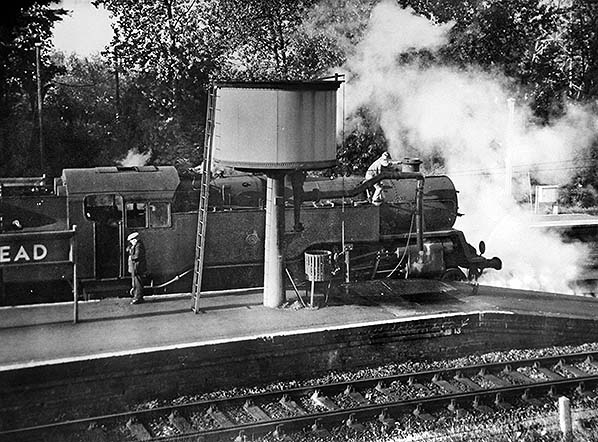 An undated view of a BR Standard 2-6-4T having just taken on water at the west end of Platform 5. Upon departure she will take the St. Margaret's Curve towards Oxted. Presumably it is the driver standing beside the cab and apparently rolling a cigarette. Most inconsiderately the photographer has allowed the running-in board to obscure the locomotive number. She carries the pre-1956 British Railways 'Cycling Lion' logo, which was in fact nothing more than an adaption for BR of the, then, British Transport Commission logo.
Photo Alan & Lynne Cullen 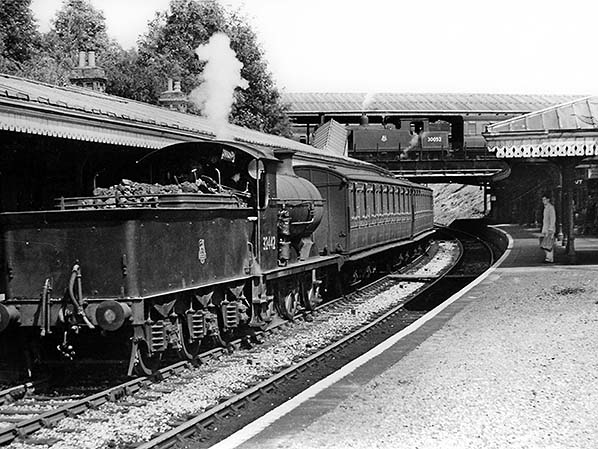 Other than what the camera his recorded, we unfortunately have no details of this photograph at all so some speculation has been included. Class M7 0-4-4T No. 30052 stands at the High Level Platform 3. There is another train present, visible to the left of the M7. At Platform 1 of the Low Level stands ex-LB&SCR Class C2X 0-6-0 No. 32442 with what appears to be a 2-set. There are no headcode discs on the tender and the train is standing 'wrong line'. Has this train arrived from the Horsted Keynes direction with the locomotive having just run round its train prior to departing southwards? The problem with this theory is that the M7 looks to be coupled to a Maunsell Push-Pull set and these conversions did not appear until late 1959, after the 'Bluebell' line had closed. Until High Level closed, Low level was something of an underused backwater with what few trains there were mostly using Platform 2 (this remained the case right up until electrification). The C2X Class was a rebuild of the C2 Class with larger boiler and extended smokebox, in which form they were slightly ungainly when viewed from the smokebox end. Some class members were also given twin domes, the 'extra' dome housing the top feed. No. 32442 lasted until February 1960 while the M7 soldiered on until May 1964. Other than what the camera his recorded, we unfortunately have no details of this photograph at all so some speculation has been included. Class M7 0-4-4T No. 30052 stands at the High Level Platform 3. There is another train present, visible to the left of the M7. At Platform 1 of the Low Level stands ex-LB&SCR Class C2X 0-6-0 No. 32442 with what appears to be a 2-set. There are no headcode discs on the tender and the train is standing 'wrong line'. Has this train arrived from the Horsted Keynes direction with the locomotive having just run round its train prior to departing southwards? The problem with this theory is that the M7 looks to be coupled to a Maunsell Push-Pull set and these conversions did not appear until late 1959, after the 'Bluebell' line had closed. Until High Level closed, Low level was something of an underused backwater with what few trains there were mostly using Platform 2 (this remained the case right up until electrification). The C2X Class was a rebuild of the C2 Class with larger boiler and extended smokebox, in which form they were slightly ungainly when viewed from the smokebox end. Some class members were also given twin domes, the 'extra' dome housing the top feed. No. 32442 lasted until February 1960 while the M7 soldiered on until May 1964.Photo Alan & Lynne Cullen Click here for East Grinstead High Level: Gallery 4 1962
 Home
Page Home
Page
|

